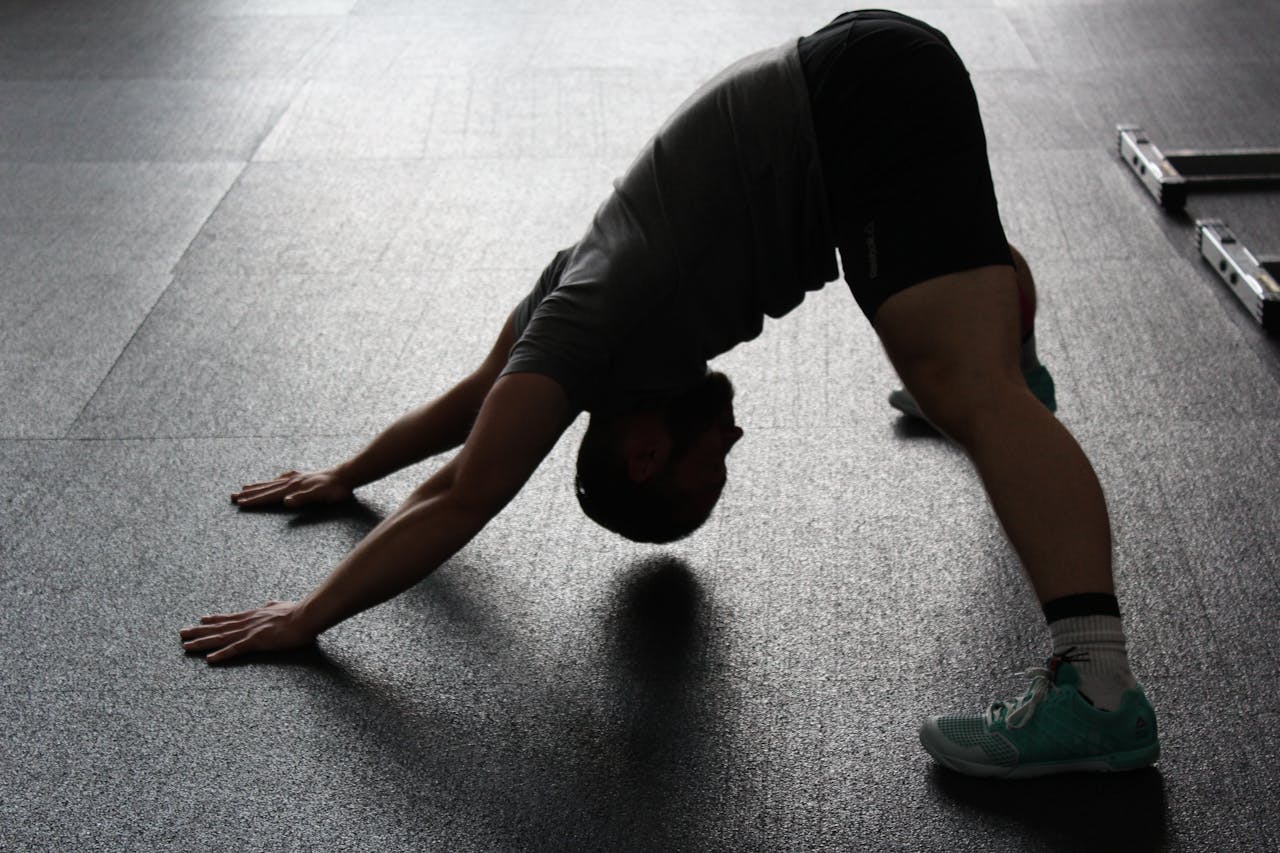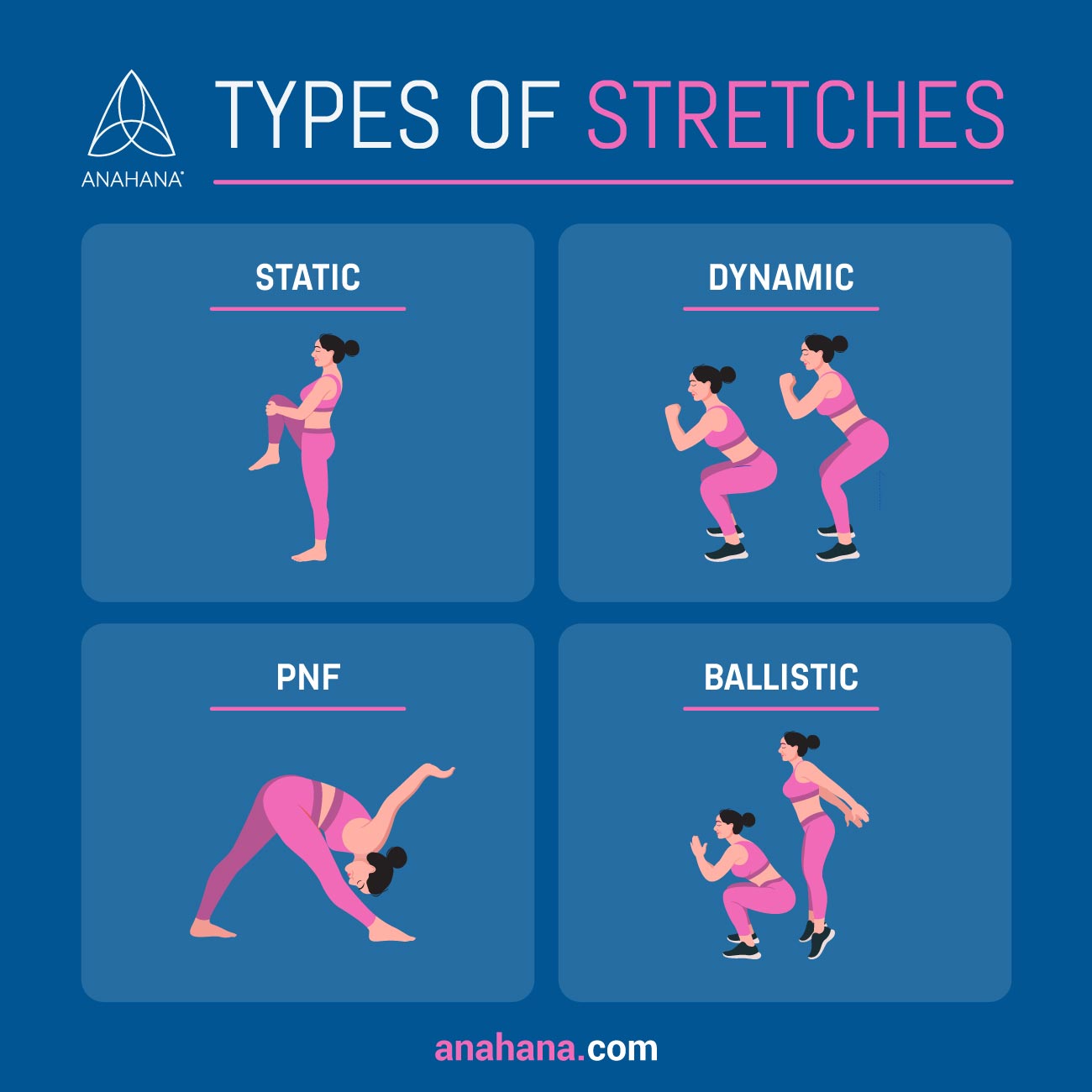
Table of Contents
Stretching builds full-body mobility, muscular flexibility, and strength and prevents injuries. Adding simple and safe stretches to a physical activity routine benefits all aspects of life.
Key Takeaways
- Definition: Stretching involves muscle stretching to lengthen muscles and tendons, improving flexibility and range of motion.
- Types: Includes static stretching (holding a position), dynamic stretching (moving through ranges of motion), and ballistic stretching (bouncing movements).
- Benefits: Enhances flexibility, improves posture, increases blood flow to muscles, reduces muscle tension, and can help prevent injuries.
- Timing: Best performed after a warm-up for dynamic stretching and post-workout for static stretching.
- Techniques: Proper technique is crucial to avoid injury; stretching should be done slowly and gently to avoid issues like tight hamstrings.
- Incorporation: Stretching, along with muscle strength exercises and exercise testing, can be integrated into daily routines, sports, and fitness programs for overall physical well-being.
Stretching is a form of exercise that puts muscles, tendons, and ligaments into their lengthened positions and forces them to extend.
Holding a muscle in this lengthened position causes the muscle to relax and relieves tension in muscle tissue, allowing the muscle to lengthen further.
Benefits of Stretching
Flexibility, Mobility, And Range Of Motion
Stretching increases flexibility, mobility, and range of motion. The primary goal of stretching is to improve flexibility.
If a muscle can easily extend to its full length, then the joints attached to that muscle can maintain their full range of motion, called mobility.
Stretching offers benefits that affect the body at the cellular level and extend throughout the entire body.
General Health And Fitness
Stretching exercises are an essential component of physical fitness and overall health.
Safe stretches keep muscles healthy, reduce the risk of injury, and improve posture and balance.
Muscle Growth
Lifting weights isn’t the only activity that grows muscles. Research has found that stretching between sets in a strength training workout may increase muscle mass.
Additionally, stretching prevents injuries, reduces downtime, faster recovery, and more gains.
Frequent, proper stretching provides better neuromuscular control and can even increase athletic performance.
Posture
Poor posture is often caused by overly tight muscles pulling the body out of a healthy position.
Keeping muscles supple through regular stretching can decrease this detrimental tightness and maintain proper posture.
Anxiety, Stress Relief, And Mental Health
Stress is one of the most significant issues facing people today. Stretching boosts serotonin levels - the happy hormone - reducing the acute effects of stress.
Stretching reduces stress hormones, meaning a quick stretch break before a big presentation or a nerve-wracking test might help take the edge off.
Pain Relief
Studies have found that stretching can reduce muscle soreness. Muscle soreness can be debilitating, especially in major muscle groups.
Delayed onset muscle soreness, or DOMS, can cause people to feel pain and stiffness in muscles one to two days after a workout and typically feels like extreme muscle tightness, sometimes even injury.
Stretching immediately after a workout may reduce the severity of DOMS.
Types of Stretches
 The body has about 600 different muscles with different functions and unique characteristics.
The body has about 600 different muscles with different functions and unique characteristics.
While most of these muscles can and should be stretched, it’s essential to find targeted stretching exercises to maximize effectiveness. There are four types of stretching:
Static
Static stretching involves holding a muscle at its full length until it fatigues.
These stretches are most effective for reducing muscle soreness, increasing muscle length, and gaining a greater range of motion.
Dynamic stretching
Dynamic stretching warms and activates cold muscles by moving them through their full range of motion.
Maintaining control, avoiding momentum, and respecting the muscles' limits is crucial.
Proprioceptive Neuromuscular Facilitation (PNF stretching)
PNF stretching involves force from the muscle being stretched and outside force pushing against it.
PNF stretching triggers the body’s compensatory relaxation reflex and is highly effective at increasing the range of motion but is riskier than other options.
Ballistic
Ballistic stretching could be described as reckless dynamic stretching and should be avoided.
Where dynamic stretches focus on gently working the muscle through its entire length, ballistic stretches carry the momentum to the end of a stretch, significantly increasing the chances of a muscle tear or tendon injury.
How to Stretch: The Basics
Stretching is simple, but some may need help getting started. These general guidelines apply to most people. People with injuries, physical conditions, illnesses, or diseases may need specialized stretching recommendations.
Before beginning any stretching program, speak with a physical therapist or sports medicine professional.
Frequency And Duration Of Stretching Workouts
Stretching once or twice per week is enough to maintain someone’s current level of flexibility. Stretching each muscle group four or more times per week hugely increases these benefits.
- Static stretching: Normally 30-60 seconds, but some stubborn muscles may need up to 90 seconds. One or two sets per muscle group are enough for significant benefits.
- Dynamic stretching: Perform 10-20 repetitions per set, with two or more sets per muscle group until muscles are warmed up.
- Stretch often: The effects of stretching dissipate after as little as 24 hours, so staying on top of a stretching routine is essential for lasting benefits.
Choosing A Stretch
Static and dynamic stretching techniques have different purposes, so choosing the proper type of stretch is crucial.
Different stretches also work on specific muscles, meaning picking the proper stretch is as important as doing it.
Static stretches should relieve muscle tension, increase muscle length, and reduce pain.
Dynamic stretching should be used for warmups, increasing blood flow and reducing injury chances before physical activity. Dynamic stretches often include light cardio, like adding butt kicks or arm circles to a gentle jog.
Cautions And Concerns
Along with the benefits of stretching come some risks. Joint pain, tendon and ligament injuries, and muscle tears can happen if stretching exercises are pushed too hard, held too long, or performed with too much momentum.
Follow these critical stretching safety tips to reduce the chances of injury:
- Never stretch to the point of pain: Stretching shouldn’t be comfortable, but it shouldn’t hurt. The goal should always be to feel tension and slight discomfort, not pain.
- Avoid bouncing movements: Stretches should be smooth
- Stay hydrated: Dry muscle tissue is much more likely to strain or tear than if it’s well-hydrated
- Warm-up: Do light exercise to get blood flow in a muscle before stretching.
- Start slow: Mobility, flexibility, and range of motion gains take time, and forcing a muscle to stretch faster can lead to injury.
- Don’t forget to breathe: Deep breaths improve the effectiveness of stretching, reduce discomfort, and cue the body to relax.
Common and Effective Stretches
There are thousands of effective stretches for each part of the body. These are just a few of the most common stretches to improve flexibility.
Hands and Arms
Wrist Flexor Stretch
Extend the hand and fingers with straight arms, pulling them back toward the forearm. Using one hand, pull the palm and fingers of the other hand further toward the forearm until a gentle stretch is felt in the lower portion of the forearm being stretched.
Over the Head Triceps Stretch
Reach the left hand behind the head, attempting to place the left hand on the small of the neck. Reach the right hand to the left elbow and pull it to the right until a stretch is felt in the left triceps.
Wall Biceps Stretch
Place the outstretched right hand on a wall with the fingers pointing behind the body. With the right elbow straight, gently rotate away from the wall until tension is felt in the biceps and up to the shoulder.
Back Stretches
Standing Side-Bends
Standing with the feet shoulder-width apart, reaching the right hand above the head, keeping the torso straight, and slowly bending to the left side until tension is felt from the left armpit down the back.
Cat-Cow
Starting with the hands directly under the shoulders, knees under the hips, and palms facing the floor, arch the upper back upward as high as possible, relaxing the shoulder blades and exhaling into the stretch to look like a scared cat.
Pull the back down from this position, letting the shoulder blades come together.
Neck Stretches
Neck Rolls
Sitting upright with relaxed shoulders, tilt the head forward and tuck the chin. Slowly roll the head to one side, moving the ear toward the shoulder.
Keep the shoulders down and relaxed, and avoid shrugging. Move the head in a full circle one way, then the other. This stretch will loosen the upper back and neck muscles and reduce tension headaches.
Leg Stretches
Standing Quadriceps Stretch
Pull the right leg forward from a neutral stance and bend the right knee, grabbing the leg around the ankle.
While staying balanced on the left foot with the left knee straight, gently pull the right ankle toward the lower back until one feels a stretch on the front side of the right leg.
Pulling the leg further back will give a deeper stretch in the quad and stretch the hip flexors.
Seated Hamstring Stretch
Sitting on the floor with the legs straight or knees slightly bent, reaching forward toward the toes until feeling the tension in the back of the legs, above the knee.
Wall-Facing Calf Stretch
Standing near a wall, lift the toes on the left leg and place them against a wall a few inches up from the floor. Lean into the wall and drive the left heel down until one feels a stretch in the calf.
Chest and Shoulder Stretches
Hands Clasped Behind the Back
Standing erect with the shoulders down, clap the hands together in the small of the back. Roll the shoulders back and push the hands toward the floor, opening up the chest.
Doorframe Pec Stretch
Place the right elbow and palm on a door frame with the elbow at shoulder level. Generating power from the hips, turn away from the doorframe until a stretch is felt through the right shoulder and pec.
Smart Stretching Tips
- Always avoid pain, and stop stretching if a muscle hurts
- Stretch often and create a routine
- Use a combination of static and dynamic stretching exercises
- Stretch the lower and upper body regularly
- Switch sides often and maintain balance
- Stay hydrated
- Develop a regular stretching routine
- Stretch before and after physical activity
References
Real Time Full Body Stretching Routine - Ask Doctor Jo
Can stretching directly cause muscle growth?
Disclaimer
The contents of this article are provided for informational purposes only and are not intended to substitute for professional medical advice, diagnosis, or treatment. It is always recommended to consult with a qualified healthcare provider before making any health-related changes or if you have any questions or concerns about your health. Anahana is not liable for any errors, omissions, or consequences that may occur from using the information provided.

By: Anahana
The Anahana team of researchers, writers, topic experts, and computer scientists come together worldwide to create educational and practical wellbeing articles, courses, and technology. Experienced professionals in mental and physical health, meditation, yoga, pilates, and many other fields collaborate to make complex topics easy to understand. Anahana is also home to specialists in crystals, tarot, angel numbers, astrology, life path numbers, zodiac signs, and horoscopes. By combining evidence-based wellness with spiritual and energetic practices, the team offers clear, trustworthy guidance for both mind-body health and modern spirituality.